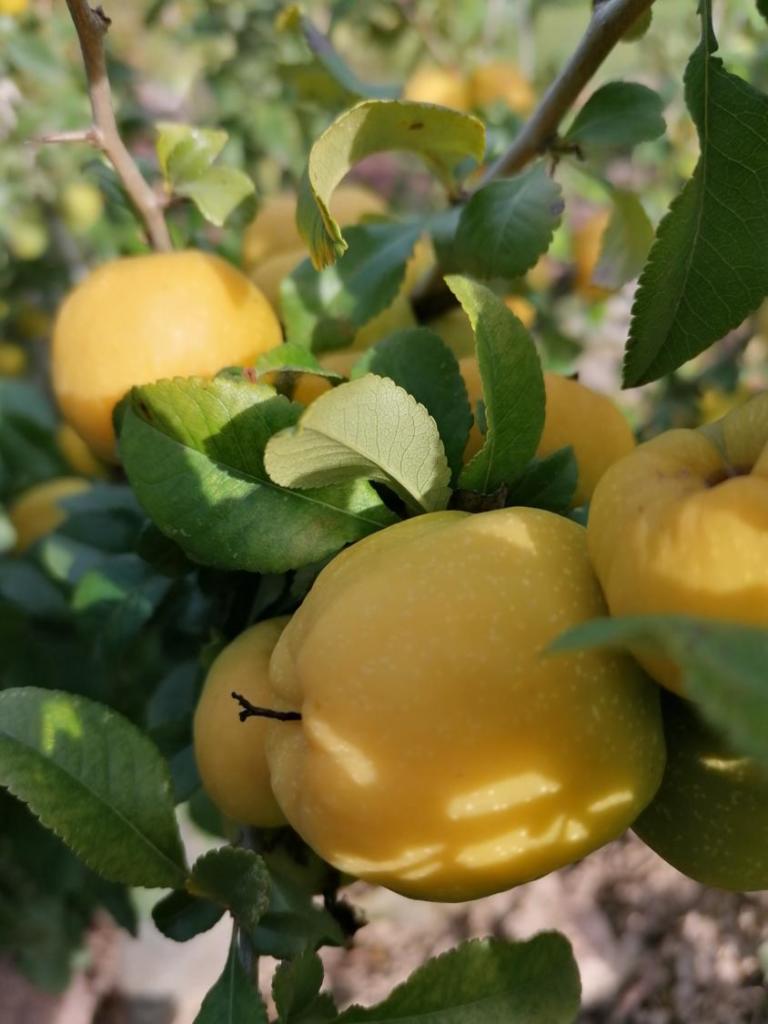I’ve just dined on homegrown quince. Not in slices with mince and not aboard a pea-green boat (like the owl and the pussycat in Edward Lear’s nonsense poem) but buttered and lightly cooked as a dessert in the comfort of the dining room. It says a lot about quince that many people know of it only through Lear’s poem rather than from eating or growing at home. This is a pity, as quince has a lot to offer both in the kitchen and in the garden.
First of all, let’s be clear on the quince I’m writing about. Confusingly, there are two garden plants called quince. The one that’s more well-known is the Japanese quince Chaenomeles speciosa. A deciduous shrub it does bear small fruit, edible if cooked, but is mainly grown as an often untidy ornamental. The quince I ate was the ‘true’ quince Latin name Cydonia oblonga. In contrast to the Oriental quince, this is a tree reaching up to eight metres in height and bearing a substantial fruit similar in size and shape to a plump pear. While also needing to be cooked it is, in my view at least, far superior to Chaenomeles and should be more widely known and grown.
That said, cultivating quince is not without challenges. Cropping can be erratic. Some years there are next to no fruit. Last year my semi-mature 25 year old tree of the variety Vranja carried less than 20 quinces. There have been years with many more but it looks unlikely the tree will ever match the productivity of its apple and pear neighbours. One reason for this is that Cydonia quince is more at home further south than Yorkshire. It’s not that the blossom is particularly susceptible to spring frost – quince flowers relatively late in May. Rather it’s because summer is usually not warm enough for the fruit to fully develop and, most of all, ripen.
Another reason Cydonia crops unreliably is that every year sees it afflicted with the fungal disease quince blight. This coats the leaves with brown blotches causing many to fall in early summer. Although recovery is swift with fresh green leaves soon thrown out, this partial defoliation stresses the tree and reduces its ability to hold and swell fruit. Unfortunately, it’s not just my tree that suffers. All trees I’m aware of in York get affected to some extent.
You might think unreliable cropping and blight are reason enough not to grow quince but there are redeeming features. Leafless winter trees can be striking with their often irregular shape and twisted, somewhat droopy, branches. In spring the pink-white blossom gives one of the best displays of any orchard tree. When not disfigured by blight the large leaves are another distinctive feature. In autumn these turn yellow, holding into early winter. But it’s the fruit that really stands out – if you get any! Baby fruitlets are alluringly tactile with silky, downy, skin. Once full-sized, the ripening fruits shine conspicuously on the tree, a striking buttery yellow. Then, when picked, there’s the distinctive perfumed fragrance. One quince can scent an entire room. Finally, comes the eating. While more or less inedible raw, when cooked, the hard flesh becomes soft, almost mushy, and takes on a pinkish tinge. The taste is subtly sweet with a slight piquancy. Best of all, the unique fragrance remains. There’s no other fruit quite like it.











Add a comment